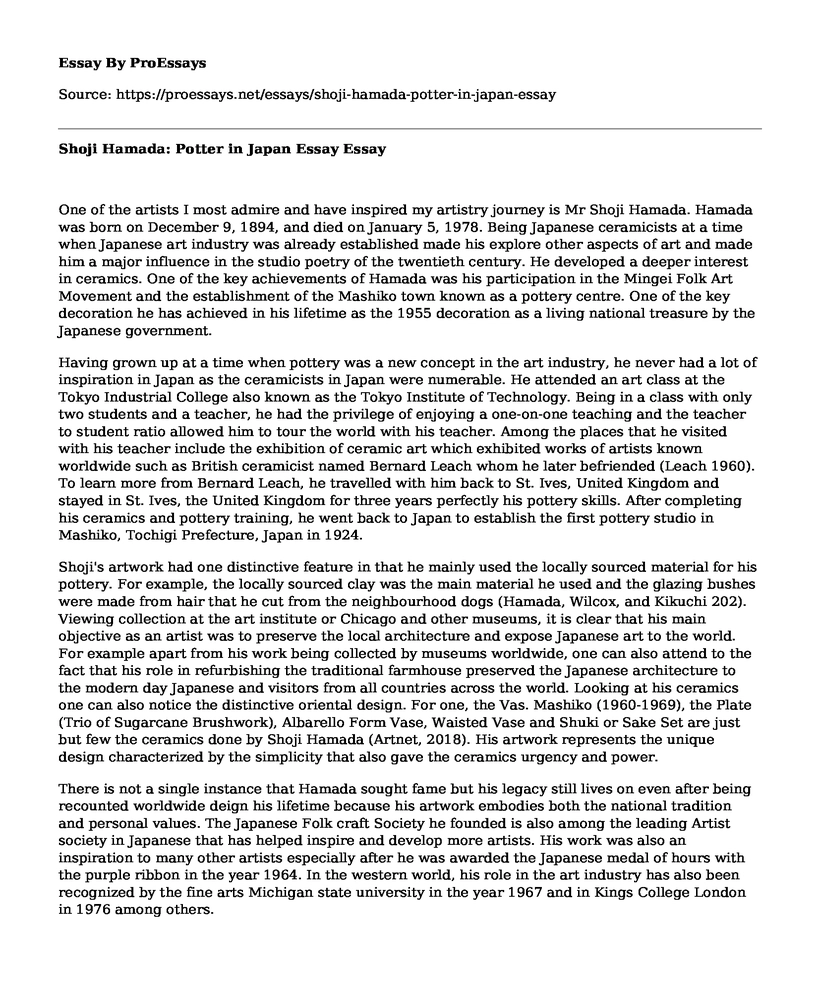One of the artists I most admire and have inspired my artistry journey is Mr Shoji Hamada. Hamada was born on December 9, 1894, and died on January 5, 1978. Being Japanese ceramicists at a time when Japanese art industry was already established made his explore other aspects of art and made him a major influence in the studio poetry of the twentieth century. He developed a deeper interest in ceramics. One of the key achievements of Hamada was his participation in the Mingei Folk Art Movement and the establishment of the Mashiko town known as a pottery centre. One of the key decoration he has achieved in his lifetime as the 1955 decoration as a living national treasure by the Japanese government.
Having grown up at a time when pottery was a new concept in the art industry, he never had a lot of inspiration in Japan as the ceramicists in Japan were numerable. He attended an art class at the Tokyo Industrial College also known as the Tokyo Institute of Technology. Being in a class with only two students and a teacher, he had the privilege of enjoying a one-on-one teaching and the teacher to student ratio allowed him to tour the world with his teacher. Among the places that he visited with his teacher include the exhibition of ceramic art which exhibited works of artists known worldwide such as British ceramicist named Bernard Leach whom he later befriended (Leach 1960). To learn more from Bernard Leach, he travelled with him back to St. Ives, United Kingdom and stayed in St. Ives, the United Kingdom for three years perfectly his pottery skills. After completing his ceramics and pottery training, he went back to Japan to establish the first pottery studio in Mashiko, Tochigi Prefecture, Japan in 1924.
Shoji's artwork had one distinctive feature in that he mainly used the locally sourced material for his pottery. For example, the locally sourced clay was the main material he used and the glazing bushes were made from hair that he cut from the neighbourhood dogs (Hamada, Wilcox, and Kikuchi 202). Viewing collection at the art institute or Chicago and other museums, it is clear that his main objective as an artist was to preserve the local architecture and expose Japanese art to the world. For example apart from his work being collected by museums worldwide, one can also attend to the fact that his role in refurbishing the traditional farmhouse preserved the Japanese architecture to the modern day Japanese and visitors from all countries across the world. Looking at his ceramics one can also notice the distinctive oriental design. For one, the Vas. Mashiko (1960-1969), the Plate (Trio of Sugarcane Brushwork), Albarello Form Vase, Waisted Vase and Shuki or Sake Set are just but few the ceramics done by Shoji Hamada (Artnet, 2018). His artwork represents the unique design characterized by the simplicity that also gave the ceramics urgency and power.
There is not a single instance that Hamada sought fame but his legacy still lives on even after being recounted worldwide deign his lifetime because his artwork embodies both the national tradition and personal values. The Japanese Folk craft Society he founded is also among the leading Artist society in Japanese that has helped inspire and develop more artists. His work was also an inspiration to many other artists especially after he was awarded the Japanese medal of hours with the purple ribbon in the year 1964. In the western world, his role in the art industry has also been recognized by the fine arts Michigan state university in the year 1967 and in Kings College London in 1976 among others.
Conclusion
In conclusion, Shoji Hamada was one of the main that that gave life and impetus to the new techniques of traditional ceramics
Works Cited
Artnet (2018). Shoji Hamada | artnet. [online] Artnet.com. Available at: http://www.artnet.com/artists/shoji-hamada/ [Accessed 12 Jun. 2018].
Bernard Leach. A Potter in Japan, 1952-1954. London: Faber and Faber, 1960
Hamada, Shoji, Timothy Wilcox, and Yuko Kikuchi. Shoji Hamada: Master Potter. London: Lund Humphries Publishers in association with Ditchling Museum: 1998.
Cite this page
Shoji Hamada: Potter in Japan Essay. (2022, Jun 19). Retrieved from https://proessays.net/essays/shoji-hamada-potter-in-japan-essay
If you are the original author of this essay and no longer wish to have it published on the ProEssays website, please click below to request its removal:
- Out of This Furnace: the US Economy in the Period Between 1880 to 1920 Essay
- A Star is Born (1937) Film Essay Example
- First-Person vs. Third Person in Storytelling Essay Example
- Essay Sample on Battle of Monte Casino
- Apocalyptic Narratives in Movies - Research Paper
- Paper Example on Balkans: Colonial Rule & Call for Independence
- Essay Sample on Samurai: Mounted Archers of Japan's History







